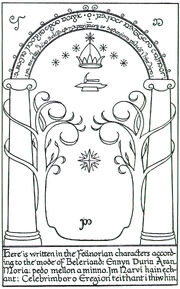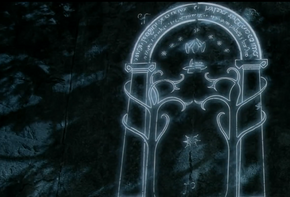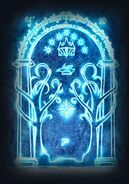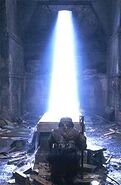Moria (also known originally as Khazad-dûm and Dwarrowdelf) was a Dwarven underground city beneath the Misty Mountains. For thousands of years, a thriving Dwarvish community had delved deep below the mountains seeking to build their lives there, and to find sources of treasure, gold and Mithril. The city was abandoned during the Third Age after excavations accidentally awoke a Balrog.
Several centuries later, an expedition led by the Dwarves Balin, Oin, and Ori attempted to reclaim and recolonize the city. Though the group was initially successful in starting a colony, it only lasted a few years before the Orcs overwhelmed it and killed all of its members. Several years later, however, the Balrog was slain by the wizard Gandalf, and the Dwarves eventually reclaimed it permanently.
History
Foundation
Moria, or as it was known in the ancient days Khazad-dûm, was founded by Durin the Deathless. Durin awoke at Mount Gundabad, in the Misty Mountains, in the period of time known as the Years of the Trees, and came upon a shimmering lake beneath the mountain Celebdil with a crown of stars reflected in its waters. He named it Kheled-zaram as it was known in Dwarvish tongue, the Mirrormere. Thereafter it remained a revered place amongst the Dwarves. In the caves above the lake, Durin's folk built Moria.[1][2]
First Age
Durin thus became King Durin l of Khazad-dum, the first of the Seven Fathers of the Dwarves.

Gates of Moria, and translation of the Writing
Many centuries later, the Dwarves continued to name their kings after him, as they believed that all other rulers of Moria were re-incarnations of Durin who wished to live amongst his people once again. Millennia passed and the caverns of Khazad-dûm became ever more famous in Middle-earth and many kings were set upon the throne of Durin the Deathless. The gates were kept open, as there was no shadow on the world at that point, and the Dwarves were on very friendly terms with the Elves.[1][3]
Second Age
In SA 40 after the fall of Beleriand in the War of Wrath and the Dwarves of Nogrod had left Middle-earth, the city was enriched in numbers, smithing, crafting, and masonry. These factors ever strengthened Khazad-dûm and brought prosperity to their city.
With the fall of Beleriand in the north, the Ñoldor looked for a new land to call home. They founded the land west of Moria, Eregion. A rare friendship sprang up between the Elves and the Dwarves of this new land, and they each aided each other in constructing the magical Western-gate of Moria, and went so far that they even presented King Durin lll with a lesser Ring of Power. The bond between Khazad-dûm and Eregion suddenly came to end as, in SA 1697, the Dark Lord Sauron corrupted the country of the elves, and despite the best efforts of the Dwarves to help them, he succeeded in destroying the fair land driving away all the elves. At this time the Doors of Durin were flung shut and sealed against Sauron's forces, and Khazad-dûm began a long seclusion from the outside world. It was at this time that the Orcs invaded Mount Gundabad, taking it from the Kingdom of Durin for themselves.
Third Age
Balrog, Durin's Bane
Throughout the beginning of the Third Age, the Dwarves of Khazad-dûm expanded its treasure, but its numbers began to dwindle. The majority of their wealth was based on their hoards of Mithril of which they mined in their deepest tunnels, and as the centuries went by the Dwarves delved ever deeper for the precious metal.
In TA 1980, they dug too deeply and greedily for Mithril and to their loss they unearthed a nameless terror in the depths beneath the city. This dreadful creature wrought destruction throughout the city wiping out most of the Dwarves and slaying King Durin VI. Thereafter the creature was named Durin's Bane. After the Dwarves had left, Khazad-dûm gathered dust and stood dark and empty, but for the sinister creature that lurked in the depths. This was when it was named Moria, the Black Pit.
The monster, later revealed as a Balrog of Morgoth, remained alone in Moria for nearly five centuries until it was populated once again, but not by Dwarves. The Orcs, refugees from the north, began to raid the abandoned city of its treasures and made a decision to occupy it. They came upon the Balrog and began to worship it as their deity. Mordor started to send out troops of Orcs and Cave Trolls to populate Moria, making an evil place for them to multiply. During the Battle of Azanulbizar, many of these Orcs were felled in the valley beneath the eastern gate of Moria in TA 2799, and the numbers were reduced dramatically. But the Balrog still remained and many Orcs and Trolls with him, and so Khazad-dûm stayed evil for the time being.
The wizard Gandalf entered the city for the first time at some point between TA 2845 and TA 2850 searching for King Thrain ll, who had recently disappeared on a journey to Lonely Mountain.
Balin's Expedition
Chamber of Mazarbul, Balin's Tomb
In TA 2989, the Longbeards, descendants of the ancient Durin Folk living at the Lonely Mountain, ignited an attempt to reclaim and recolonize their ancestral dwelling - Khazad-dûm. The expedition was led by Balin son of Fundin, one of Thorin Oakenshield's Company of Dwarves who accompanied Bilbo Baggins on the Quest of Erebor. He led a group of Dwarves from Lonely Mountain to Moria, and successfully eviscerated a considerable amount of Orcs, taking many of the eastern halls and recovering priceless ancestral treasures such as Durin's Axe. However, the number of Orcs was too great compared to their small company and all, including Balin, were slain in TA 2994.
Quest of the Ring

The Fellowship passing through the great halls of stone.
When the Hobbits Frodo, Sam, Merry and Pippin; the Men Aragorn and Boromir; the Dwarf Gimli; the Elf Legolas; and the Wizard Gandalf set out from Rivendell on the Quest of the Ring, they were forced to make their way through Moria after the failed attempt of climbing Caradhras (Redhorn) where they were pursued by Wargs. They entered through the western-gate near a lake with dark waters from which a tentacular monster emerged and attempted to kill Frodo. When inside, the Fellowship passed through many tunnels and great halls until finally reaching the Chamber of Mazarbul. It was here that they came across Balin's Tomb and a book, explaining the last accounts of the Longbeards.[4]
They were then taken by surprise as Orcs and cave trolls pursued them through Moria to the Bridge of Khazad-dûm where the Balrog rose from the depths. Gandalf bravely confronted the creature and the two briefly dueled on the bridge before plunging together into the abyss below. This saved Gandalf's friends' lives as they carried on out of Moria into Dimrill Dale. Gandalf and the Balrog both survived the fall; the wizard then pursued the monster up the Endless Stair to the peak of Celebdil, where a final battle took place. In the end, Gandalf defeated the Balrog and cast its corpse down onto the mountain side, before succumbing to the wounds of his battle.[5]
Fourth Age and beyond
Eventually, Moria was reclaimed by the Dwarves of Durin's Folk under Durin VII who became King of Durin's Folk and of Khazad-dûm and lived there ever after.
Etymology
Moria means "black chasm"' in Sindarin. Khazad-dûm means "Delving of the Dwarves" in Dwarvish.[6]
Other names
- Dwarrowdelf
- Hadhodrond
- Halls of Durin
- Mines of Moria
- Phurunargian
Portrayal in adaptations

Durin's door
Moria is depicted in both Ralph Bakshi's 1978 animated film The Lord of the Rings and the 2001 live action film The Fellowship of the Ring.
The Hobbit film trilogy
Moria appears in the film adaptation of The Hobbit, in a flashback sequence where Azog killed Thrór, only to be defeated himself by Thorin Oakenshield who cuts off his hand, none of which happened in (or is consistent with) what Tolkien wrote.
Video games
It is also depicted in the video games The Lord of the Rings: Conquest, The Lord of the Rings: The Battle for Middle-earth, The Lord of the Rings: The Fellowship of the Ring (video game), The Lord of the Rings: The Third Age, The Lord of the Rings Online, and The Lord of the Rings: Aragorn's Quest.
Gallery
| Dwarven realms of Middle-earth throughout the Ages | |
|---|---|
| Years of the Trees and First Age: | Amon Rûdh | Belegost | Khazad-dûm | Mount Gundabad | Nogrod | Narukuthûn | Blue Mountains |
| Second Age: | Khazad-dûm | Belegost | Nogrod | Mount Gundabad | Blue Mountains | Iron Hills |
| Third Age: | Grey Mountains | Iron Hills | Khazad-dûm | Lonely Mountain | Blue Mountains | Dunland |
| Fourth Age: | Glittering Caves | Khazad-dûm | Lonely Mountain | Blue Mountains | Iron Hills |
Translations around the World
| Foreign Language | Translated name |
|---|---|
| Arabic | موريا |
| Amharic | ሞሪኣ |
| Armenian | Մորիա |
| Belarusian Cyrilic | Морыя |
| Bengali | মরিঅ |
| Bosnian | Morija |
| Bulgarian Cyrilic | Мория |
| Catalan | Mòria |
| Chinese (Hong Kong) | 摩瑞亞 |
| Dari | موریا |
| Georgian | მორია |
| Greek | Μορια |
| Gujarati | મોરિઅ |
| Hebrew | מוריה |
| Hindi | मोरिअ |
| Hungarian | Mória |
| Japanese | モリア |
| Kazakh Cyrilic | Моріа |
| Korean | 모리아 |
| Kurdish | مۆریا |
| Kyrgyz Cyrilic | Мориа |
| Lao | ມໂrິະ |
| Latin | Moriae |
| Macedonian Cyrilic | Мориа |
| Mongolian Cyrilic | Мориа |
| Nepali | मोरिअ |
| Norwegian | Moria |
| Pashto | موریا |
| Persian | موریا |
| Russian | Мориа |
| Sanskrit | मोरिअ |
| Serbian | Морија (Cyrillic) Moria (Latin} |
| Thai | คาซัดดูม |
| Sinhala | මොරියා |
| Tajik Cyrillic | Мориа |
| Telugu | మొరిఅ |
| Tibetan | མོརིཨ ? |
| Tigrinya | ሞሪኣ |
| Ukrainian Cyrillic | Морія |
| Urdu | موریا |
| Uzbek | Мориа (Cyrillic) Moria (Latin) |
| Uyghur | مورىا |
| Yiddish | מאָריאַ |
References
- ↑ 1.0 1.1 The Atlas of Middle-earth, The Third Age, "Migrations of Hobbits"
- ↑ The Atlas of Middle-earth, The Lord of the Rings, "Moria"
- ↑ The Atlas of Middle-earth, The Lord of the Rings, "Moria"
- ↑ The Lord of the Rings, The Fellowship of the Ring, Book Two, Chapter IV: "A Journey in the Dark"
- ↑ The Lord of the Rings, The Fellowship of the Ring, Book Two, Chapter V: "The Bridge of Khazad-dûm"
- ↑ The Complete Guide to Middle-earth





